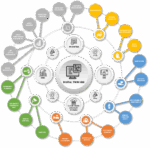
New Technology Behind Emergency Bridge Construction
Hurricanes, earthquakes, and tsunamis are becoming more common around the world than ever before, and construction has often struggled to keep up. These types of natural disasters are known to cause flooding, which prohibits transportation flow and blocks crucial escape routes for people who live in areas hit by storms. Fortunately, engineers have been testing solutions for this common problem and developing emergency bridges that have the potential to save thousands of lives.
Key Features of Emergency Bridges
During times of natural disasters and other emergencies, bridges are needed not only to evacuate affected areas, but also to deliver supplies and medical care to survivors after the storm has passed. Serious injuries require immediate attention, so bridges should have multiple lanes to allow emergency vehicles to pass by other traffic.
Since structural engineers and construction professional may not be readily available to set up a bridge during an emergency, these bridges should be simple enough for ordinary citizens to construct in a safe and efficient way.
Mobile Bridge® Version 4.0
At Hiroshima University, researchers set up an emergency bridge structure with a scissor-like shape to test its effectiveness for vehicular traffic over a river. Mobile Bridge has a foldable design that can be set up and taken down quickly and easily. The scissor design is patented technology that can be hauled from one location to another with a simple car trailer.
Dr. Ichiro Ario from the Institute of Engineering at Hiroshima University said that the inspiration for the bridge came from Origami, a paper craft that utilizes expansions and contractions to retain structural strength. At present, it is the world’s strongest, lightest weight, and largest temporary bridge that’s easy to set up and take down. It takes about one hour to get the bridge ready to use after it arrives onsite.
Testing Results
Dr. Ario presented the results of these bridge tests at a Japan Society of Civil Engineers symposium in June. The results were overwhelmingly positive, as cars could travel across the bridge without issues and it took very few people to set it up. The bridge is also a cost-effective option because it doesn’t require the use of costly cranes, building a foundation, or extensive labor.
“From this test of a new bridge concept, the next generation of bridge technology starts on a new stage in the field of bridge engineering,” Dr. Ario said. “It is possible to use a real deployable and smart bridge with a scissor-type bridge system using this structural theory. I will further promote the development and evolution of MB4.0 in the future. Making MB stronger, longer, lighter, more compact, and quicker to set up will promote the development of infrastructure construction technology in general.”
Non-Emergency Usage
However, the Mobile Bridge technology has wider applications than just natural disaster usage. In many places, bridges are in need of repair and blocking them off for construction creates a traffic nightmare. Continued traffic on poor bridges causes them to deteriorate even further, posing serious safety risks. These types of bridges could also be set up in non-emergency construction situations to ease the flow of traffic through an alternate route.
Other emergency bridge engineering companies that have been making strides in this important field include South Wales-based Mabey Bridge, Acrow Bridge in New Jersey, and Unibridge in Sydney, Australia.
Photo credit: Hiroshima University



